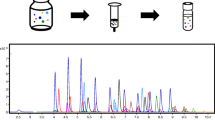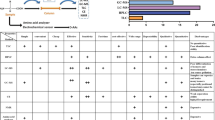Abstract
A simple method for the determination of bile acids in adult human fecal samples using GC-MS is described. Bile acids are directly extracted from feces by ethanol (95%) containing 0.1 N NaOH. Extracts are purified by passage through a reversed-phase C18 silica cartridge and then analyzed by GC-MS. The present study has shown that lyophilized human feces contain mainly free bile acids, with lithocholic acid (LCA) and deoxycholic acid (DCA) as the major bile acids; however, isomers of LCA and DCA, keto-bile acids, and cholic acid are also present. Any traces of conjugated bile acids are hydrolyzed before the C18 extraction by deconjugating enzymes, which are present in feces and are activated by the addition of water during the homogenization step. Thus, the analysis of fecal bile acids can be performed without the hydrolysis step in less than 4 h in comparison to traditional techniques, which usually require at least 48 h.
Similar content being viewed by others
Abbreviations
- CA:
-
cholic acid
- DCA:
-
deoxycholic acid
- ES-MS-MS:
-
electrospray tandem MS
- LCA:
-
lithocholic acid
References
Vlahcevic, Z.R., Pandak, W.M., and Stravitz, R.T. (1999) Regulation of Bile Acid Biosynthesis, Gastroenterol. Clin. North Am. 28, 1–25.
Hoffman, A.F. (1994) Bile Acids, in The Liver: Biology and Pathobiology (Arias, I.M., Boyer, J., Fausto, L., Jakoby, N., and Schachter, W.B., eds.), 3rd edn., pp. 677–718, Raven Press, New York.
Carey, M.C., and Duane, W.C. (1994) Enterohepatic Circulation, in The Liver: Biology and Pathobiology (Arias, I.M., Boyer, J., Fausto, L., Jakoby, N., and Schachter, W.B., eds.), 3rd edn., pp. 719–768, Raven Press, New York.
Kasbo, J., Saleem, M., Perwaiz, S., Mignault, D., Lamireau, T., Tuchweber, B., and Yousef, I. (2002) Biliary, Fecal, and Plasma Deoxycholic Acid in Rabbit, Hamster, Guinea Pig, and Rat: Comparative Study and Implication in Colon Cancer, Biol. Pharm. Bull. 25, 1381–1384.
Bernstein, C., Bernstein, H., Garewal, H., Dinning, P., Jabi, R., Sampliner, R.E., McCuskey, M.K., Panda, M., Roe, D.J., L'Heureux, L., and Payne, C. (1999) A Bile Acid-Induced Apoptosis Assay for Colon Cancer Risk and Associated Quality Control Studies, Cancer Res. 59, 2353–2357.
Powolny, A., Xu, J., and Loo, G. (2001) Deoxycholate Induces DNA Damage and Apoptosis in Human Colon Epithelial Cells Expressing Either Mutant or Wild-Type p53, Int. J. Biochem. Cell Biol. 33, 193–203.
Reddy, B.S. (1999) Prevention of Colon Carcinogenesis by Components of Dietary Fiber, Anticancer Res. 19, 3681–3683.
Ochsenkuhn, T., Bayerdorffer, E., Meining, A., Schinkel, M., Thiede, C., Nussler, V., Sackmann, M., Hatz, R., Neubauer, A., and Paumgartner, G. (1999) Colonic Mucosal Proliferation Is Related to Serum Deoxycholic Acid Levels, Cancer. 85, 1664–1669.
Hirano, S., Masuda, N., Oda, H., and Imamura, T. (1981) Transformation of Bile Acids by Mixed Microbial Cultures from Human Feces and Bile Acid Transforming Activities of Isolated Bacterial Strains, Microbiol. Immunol. 25, 271–282.
White, B.A., Lipsky, R.L., Fricke, R.J., and Hylemon, P.B. (1980) Bile Acid Induction Specificity of 7 α-Dehydroxylase Activity in an Intestinal Eubacterium Species, Steroids 35, 103–109.
Batta, A.K., Salen, G., Rapole, K.R., Batta, M., Batta, P., Alberts, D., and Earnest, D. (1999) Highly Simplified Method for Gas-Liquid Chromatographic Quantitation of Bile Acids and Sterols in Human Stool, J. Lipid Res. 40, 1148–1154.
van Faassen, A., Nagengast, F.M., Hectors, M., van den Broek, W.J., Huijbregts, A.W., van der Werf, S.D., van Berge Henegouwen, G.P., and van Tongeren, J.H. (1985) Determination of Individual Human Faecal Bile Acids by Gas-Liquid Chromatography After Enzymatic Deconjugation and Simultaneous Solvolysis and Methylation Using Dimethoxypropane, Clin. Chim. Acta 31, 231–239.
Setchell, K.D., Ives, J.A., Cashmore, G.C., and Lawson, A.M. (1987) On the Homogeneity of Stools with Respect to Bile Acid Composition and Normal Day-to-Day Variations: A Detailed Qualitative and Quantitative Study Using Capillary Column Gas Chromatography-Mass Spectrometry, Clin. Chim. Acta 162, 257–275.
Perwaiz, S., Tuchweber, B., Mignault, D., Gilat, T., and Yousef, I. (2001) Determination of Bile Acids in Biological Fluids by Liquid Chromatography-Electrospray Tandem Mass Spectrometry, J. Lipid Res. 42, 114–119.
Ferguson, L.R., Rewcastle, G.W., Lello, J.M., Alley, P.G., and Seelye, R.N. (1984) Quantitation of Free and Conjugated Bile Acids in Human Feces Using a High-Pressure Liquid Chromatography Counter Ion Method, Anal. Biochem. 143, 325–332.
Author information
Authors and Affiliations
Corresponding author
About this article
Cite this article
Perwaiz, S., Mignault, D., Tuchweber, B. et al. Rapid and improved method for the determination of bile acids in human feces using MS. Lipids 37, 1093–1100 (2002). https://doi.org/10.1007/s11745-002-1005-0
Received:
Revised:
Accepted:
Issue Date:
DOI: https://doi.org/10.1007/s11745-002-1005-0




